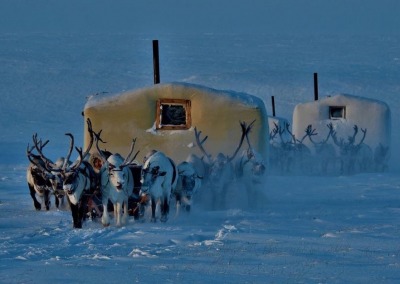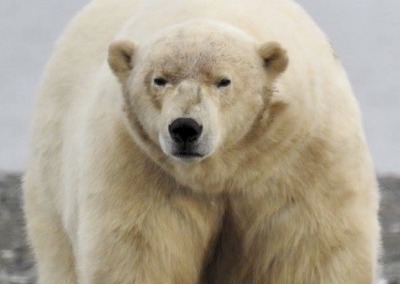The Taymyr Peninsula
The Taymyr Peninsula is the northernmost part of the Eurasian landmass, or any continental landmass in the world. Further north, whether in Eurasia or North America, there are only islands. It is thousands of kilometres from the nearest road or rail network. Access is forbidden to all outsiders who do not go through the laborious process of obtaining a temporary access permit. This vast wilderness is truly one of travel’s last frontiers. It is home to nomadic reindeer herders, mammoth tusk hunters, vast walrus rookeries, the polar bears that prey on them, the world’s largest reindeer herd (1 million head), colonies of up to 1 million birds, muskox, seals, white beluga whales, snowy owls, lemmings, Arctic fox, spectacularly pristine nature and the remains of the occasional gulag concentration camp. In short, it is a paradise for wildlife lovers and adventure travellers.
For most of the year, there are lots of polar bears living on the ice of the seas around the Taymyr Peninsula. Usually they prey on seals and sometimes walrus. However, when the ice recedes during the brief summer, seals become very hard to find and walrus move onto the land. Walrus form large colonies on spits, ranging in size from a few hundred to tens of thousands. They choose the same spits every year. A number of polar bears follow them ever year, hanging around the colony and picking off a walrus whenever they get hungry. If you know the spits where the colonies form and visit at a time of year when the ice is sure to have receded, you are thus virtually guaranteed to see a large walrus colony and some polar bears.
The spits where these colonies form are far north on the Taymyr Peninsula. We usually access them by boat, sailing north up the River Khatanga. At the time when the sea is ice free, the migration of the 1-million head wild reindeer herd happens to be crossing this river. You constantly see groups of reindeer running along the river banks or swimming from one side to the other.
The border with Yakutia is also very close, so we combine our Taymyr Peninsula tours with visits to Yakutia‘s Arctic Ocean islands. Here, we know the location of another walrus colony and a cliff with over a million nesting birds.
The indigenous people in this part of Taymyr and Yakutia are mostly Dolgans. There are a few Nganasan on Taymyr too, but there are no purely Nganasan villages or nomad camps left. They mostly live with the Dolgans. While there are 7,000 Dolgans in total, there are only around 800 Nganasan left and most of them sadly do not speak their own language any more.
Some Dolgans live by fishing, searching for mammoth tusks and hunting the 1-million head wild reindeer herd that migrates through the area. Others are nomadic reindeer herders who build wooden cabins on sledges and cover them with reindeer furs for insulation. When they migrate to new pastures (once every 10 days in winter or once every 2 – 3 days in summer), the reindeer pull the whole home.
We are highly likely to meet the Dolgans on all our trips to Taymyr. However, they are not the goal of our main itinerary, which is focused on wildlife spotting. If you are interested in immersing yourself in the Dolgan way of life, we offer the opportunity to join them on their epic migrations. We run these trips just across the border in Yakutia, as the Dolgans there have preserved bigger reindeer herds and migrate more often. Please see our Dolgan migration tour page for more details.
As well as our standard Taymyr Peninsula itinerary below, we are happy to create totally new tailored trips based on your own goals and requirements. We can organise expeditions of any complexity in the region. We can provide all-terrain vehicles and private helicopters to access even the northernmost points of this spectacularly remote part of the world. Please get in contact for more details.
The Taymyr Peninsula is the northernmost part of the Eurasian landmass, or any continental landmass in the world. Further north, whether in Eurasia or North America, there are only islands. It is thousands of kilometres from the nearest road or rail network. Access is forbidden to all outsiders who do not go through the laborious process of obtaining a temporary access permit. This vast wilderness is truly one of travel’s last frontiers. It is home to nomadic reindeer herders, mammoth tusk hunters, vast walrus rookeries, the polar bears that prey on them, the world’s largest reindeer herd (1 million head), colonies of up to 1 million birds, muskox, seals, white beluga whales, snowy owls, lemmings, Arctic fox, spectacularly pristine nature and the remains of the occasional gulag concentration camp. In short, it is a paradise for wildlife lovers and adventure travellers.
For most of the year, there are lots of polar bears living on the ice of the seas around the Taymyr Peninsula. Usually they prey on seals and sometimes walrus. However, when the ice recedes during the brief summer, seals become very hard to find and walrus move onto the land. Walrus form large colonies on spits, ranging in size from a few hundred to tens of thousands. They choose the same spits every year. A number of polar bears follow them ever year, hanging around the colony and picking off a walrus whenever they get hungry. If you know the spits where the colonies form and visit at a time of year when the ice is sure to have receded, you are thus virtually guaranteed to see a large walrus colony and some polar bears.
The spits where these colonies form are far north on the Taymyr Peninsula. We usually access them by boat, sailing north up the River Khatanga. At the time when the sea is ice free, the migration of the 1-million head wild reindeer herd happens to be crossing this river. You constantly see groups of reindeer running along the river banks or swimming from one side to the other.
The border with Yakutia is also very close, so we combine our Taymyr Peninsula tours with visits to Yakutia‘s Arctic Ocean islands. Here, we know the location of another walrus colony and a cliff with over a million nesting birds.
The indigenous people in this part of Taymyr and Yakutia are mostly Dolgans. There are a few Nganasan on Taymyr too, but there are no purely Nganasan villages or nomad camps left. They mostly live with the Dolgans. While there are 7,000 Dolgans in total, there are only around 800 Nganasan left and most of them sadly do not speak their own language any more.
Some Dolgans live by fishing, searching for mammoth tusks and hunting the 1-million head wild reindeer herd that migrates through the area. Others are nomadic reindeer herders who build wooden cabins on sledges and cover them with reindeer furs for insulation. When they migrate to new pastures (once every 10 days in winter or once every 2 – 3 days in summer), the reindeer pull the whole home.
We are highly likely to meet the Dolgans on all our trips to Taymyr. However, they are not the goal of our main itinerary, which is focused on wildlife spotting. If you are interested in immersing yourself in the Dolgan way of life, we offer the opportunity to join them on their epic migrations. We run these trips just across the border in Yakutia, as the Dolgans there have preserved bigger reindeer herds and migrate more often. Please see our Dolgan migration tour page for more details.
As well as our standard Taymyr Peninsula itinerary below, we are happy to create totally new tailored trips based on your own goals and requirements. We can organise expeditions of any complexity in the region. We can provide all-terrain vehicles and private helicopters to access even the northernmost points of this spectacularly remote part of the world. Please get in contact for more details.


